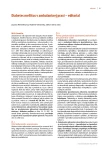Importance of self-monitoring of blood glucose
Authors:
Radovan Plášil 1; Zuzana Némethyová 2; Vladimír Uličiansky 3
Authors‘ workplace:
Ambulancia pre diabetológiu, poruchy látkovej premeny a výživy, Vrútky
1; Dia centrum plus, s. r. o., Bratislava
2; Via medica, s. r. o., Košice
3
Published in:
Forum Diab 2015; 4(2): 125-127
Category:
Main Theme: Review
Overview
Self-monitoring of blood glucose (SMBG) is one of the basic parameters of evaluating the quality and safety of the treatment of patients with all types of diabetes. It is based on consistent performance and comprehensive assessment. In the past SMBG was only required for diabetic patients treated with insulin. Within last decade, in an effort to achieve tighter compensation of diabetes, SMBG has also been increasingly used for patients receiving oral antidiabetic medications (OAD), in particular those related with the risk of developing hypoglycemia. An increased emphasis is placed on the control of postprandial glucose.
Key words:
diabetes mellitus – self-monitoring of blood glucose
Sources
1. Schnell O, Alawi H, Batellino T. Adressing schemes of selfmonitoring BG. Diabetes Technol Ther 2011; 13(9): 959–965.
2. Czupryniak L, Barkai L, Martinka E. Self-Monitoring of Blood Glucose in Diabetes: From Evidence to Clinical Reality in Central and Eastern Europe – Recommendations from International Central – Eastern European Expert Group. Diabetes Technol Ther 2014; 16(7): 460–475.
3. Ceriello A. Self-monitoring of blood glucose in type 2 diabetes: is the debate (finally) ending? Diabetes Res Clin Pract 2012; 97(1): 1–2.
4. Malanda UL, Welschen LM, Riphagen I et al. Self-monitoring of blood glucose in patients with type 2 diabetes mellitus who are not using insulin. Cochrane Database Syst Rev 2012; 1: CD005060. Dostupné z DOI: <http://dx.doi.org/10.1002/14651858.CD005060.pub3>.
5. Polonsky WH, Fischer L. Self-Monitoring of Blood Glucose in Noninsulin-Using Type 2 Diabetic Patients: Right answer but wrong question. Diabetes Care 2013; 36(1): 179–182.
6. Cox DJ, Gonder-Frederick LA, Polonsky WH et al. Blood glucose awareness training (BGAT-2): long-term benefits. Diabetes Care 2001; 24(4): 637–642.
7. Polonsky WH, Fisher L, Schikman CH et al. Structured self-monitoring of blood glucose significantly reduces A1C levels in poorly controlled, noninsulin-treated type 2 diabetes: results from the Structured Testing Program study. Diabetes Care 2011; 34(2): 262–267.
8. Kleefstra N, Hortensius J, Logtenberg SJ et al. Self-monitoring of blood glucose in tablet-treated type 2 diabetic patients (ZODIAC). Neth J Med 2010; 68(1): 311–316.
9. Monnier L, Lapinski H, Colette C. Contributions of Fasting and Postprandial Plasma Glucose Increments to the Overall Diurnal Hyperglycemia of Type 2 Diabetic Patients. Diabetes Care 2003; 26(3): 881–885.
10. Jovanovic L. Using meal-based self-monitoring blood glucose (SMBG) data to guide dietary recommendations in patients with diabetes. Diabetes Educ 2009; 35(6): 1023–1030.
11. Schütt M, Kern W, Krause U et al. Is the frequency of self-monitoring of blood glucose related to long-term metabolic control? Multicenter analysis including 24,500 patients from 191 centers in Germany and Austria. Exp Clin Endocrinol Diabetes 2006, 114(7): 384–388.
Labels
Diabetology Endocrinology Internal medicineArticle was published in
Forum Diabetologicum

2015 Issue 2
Most read in this issue
- Acute complications of diabetes mellitus from out-patient department perspective
- Dermatologic manifestations of diabetes
- The most common gynecologic problems in diabetic women
- Chronical diabetic complications from point of view of modern diabetology
